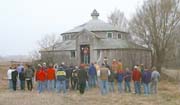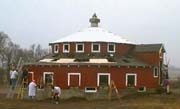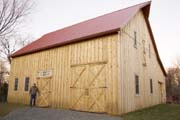 |
|||||||||
|
|||||||||
Barn RazingWill Maryland Tobacco Barns Go up in Smoke?by Margaret Tearman
“I hear you’re interested in saving barns,” the lady in the Southern States farm supply store whispered to me. “Well, I have a sad story for you. Just down the road there’s a beautiful old barn that’s going to be torn down. The homeowner thinks the barn is old, ugly and in the way of the new house he’s building.” Following directions from my source, I found the construction site — and the marked barn. It is indeed a beauty, still in good shape, standing tall and proud. The guys running the cement mixers agreed as they poured the foundation for the new home being built just a stone’s throw away from the old barn. “It’s going to be bulldozed any day now,” said one. “It was s’posed to be torn down last fall until a group of people who live on this road got involved to try and save it.” The barn was not saved, its demise only postponed. “The neighbors,” the workman said, “are pretty upset about losing this old barn.” It’s a different story for Gary O’Shea’s neighbors in Dunkirk. Ten years ago, O’Shea purchased five acres that included an old, vine-covered tobacco barn. When it came time to start building his new home, the barn’s location on the property posed a dilemma. “When I started plotting out my house, figuring out how it would fit on the lot, it seemed like the barn was in the way,” recalls O’Shea. “I wasn’t sure what to do with the barn. Should it stay or should it go? So I asked my neighbors if they thought it was an eyesore, if they thought I should tear it down. I thought that was the neighborly thing to do. Well, no one wanted me to tear it down. They all asked me to keep it.” O’Shea not only kept the barn, he has since restored it. “It has turned out really nice,” O’Shea says. “The house was built with the barn as a backdrop. Everyone seems very pleased, and I’m happy we kept it.” Throughout history, barns have brought communities together with barn raising and barn dances. Today, barns are bringing people together for a new reason: to save their barns. Barn LoveLove is the thing that enables a woman to sing while she mops up the floor after her husband has walked across it in his barn boots.–Hoosier Farmer
My husband and I are building a barn, an old-fashioned wood barn, not one of these new-fangled metal structures. Our barn won’t be home to pigs or cows, and it will never see hands of drying tobacco hanging from the rafters. Instead it will house a woodworking shop and at least one of our cars. We could have made do with an ordinary garage, but we wanted a barn. I was raised in Southern California where I could only fantasize about the country life. My husband comes from a long line of Indiana farmers, and a barn is an emotional connection to his family and to the land that supported so many generations of Tearmans. We wish we owned an old barn, a genuine piece of the original Calvert County farmstead. The farmhouse survived, but the barns didn’t fare so well. This is true of many farms in Southern Maryland, as tobacco is replaced by other crops and fields are being filled with subdivisions. Icons of a unique agricultural heritage, tobacco barns are being demolished at an alarming rate. “We only have guesses as to how many tobacco barns survive in Southern Maryland,” says Kirstie Uunila, Calvert County’s historic planner. “The number we’ve been using is 5,000, but that is arbitrary, and we do not have the resources to go out and ground-truth it. In Calvert I would estimate there are around 1,000 barns or fewer. I probably review the potential demise of about 50 barns or more each year.” In 2001, a state-sponsored program to discourage tobacco cultivation offered farmers a substantial payment if they stopped growing tobacco. Almost all of Maryland’s approximately 1,000 tobacco farmers accepted the buyout. Now they no longer cultivate what was once Maryland’s primary money crop. The buyout made hundreds of tobacco barns instantly obsolete. Frank Wood is one of the last remaining tobacco growers in Calvert County, and he’s got a problem. He needs multiple barns to cure his harvest, and those barns are getting hard to find. “If you took the buyout,” Wood explains, “part of the contractual agreement said you could not use your barns for production or storage of tobacco, any tobacco, for the rest of your life.” Before the buyout, Wood had enough barns for his 30-acre crop. But when his father, in declining health, accepted the buyout, Wood lost the use of the barns located on his father’s portion of their farm. “Barns on property in production prior to the buyout weren’t being used, so they weren’t kept up,” Wood says. “The barns that were maintained were used in tobacco production. When the owners took the buyout, all of those barns became unavailable to me.” On average, it takes one barn to cure two acres of tobacco. Today, Wood farms on just 10 acres, and he must rent barns, which are few and far between, to cure his tobacco. Wood just completed some restoration work on his only barn. Practically, he needs the space, but he is also proud of his heritage, and the barn symbolizes generations of his family’s work. “It’s important to me to keep it looking good,” he says, “in as good as shape as when it was built back in 1940.” In June 2004, the National Trust for Historic Preservation named Southern Maryland’s tobacco barns one of America’s 11 Most Endangered Historic Places. The tobacco barns are defining symbols of Southern Maryland,” said Richard Moe, president of the Trust, who owns a second home in Calvert. “It is critical that landowners, preservationists and community leaders work together to preserve these historic barns and their agricultural and historic landscapes, which are vital to telling the story of the region’s rich heritage.”
Barn Again
Saving barns is not just a Southern Maryland effort. Across the country, communities are working together to save their barns. In Wakefield, Nebraska, Kirby Mousel’s art students at Wakefield Community School discovered the dilapidated Barleman Round Barn as part of a school architectural research project. “The students were to adopt a barn from our local county, Dixon, and study its architecture and history,” Mousel told Bay Weekly. “During a field-trip, we discovered the round hog barn on an old abandoned farm, obscured by trees and over-grown brush. We fell in love with it.” Because the barn wasn’t located in Dixon County, it wasn’t used for the class project. But Mousel felt the barn was worthy of restoration. “I located the current owner, Ward Barleman,” he says. “He agreed to donate it to the community for restoration.” Working with the school administration and other teachers, Mousel garnered support for the restoration project. “We teamed up with three other teachers and worked with 120 students in two shifts during the school day as a part of a special community-based class,” he says. Working with funds provided by the Walter Annenburg Foundation, the students cleared the surrounding land and the barn of overgrown vegetation, stripped off the old shingles, installed a temporary roof, painted the exterior and removed part of the cement floor. Work is ongoing. The long-term plan includes relocating the barn to a new site in town, where it would be used as a museum. Barn preservation isn’t limited to the traditional farming areas of America’s Midwest and eastern states. Although not as plentiful as barns in farming regions, barns in western states have their place in local culture and history. Early hand-hewn log barns sheltered livestock through fierce western winters and still serve ranchers today. They are being preserved not only out of necessity but also because of their place in the history of the Wild West. On our summer tour of Colorado’s Powderhorn Valley, our guide veered off the highway and took us down a dusty ranch road to proudly point out one of the “most photographed buildings in Colorado”: an old, hand-hewn log barn. An elk skull, bleached white by the intense mountain sun, was traditionally mounted on the front peak, and the original oilcloth still hung in the windows. Lovingly preserved and respected, the Caldwell family’s barn is still in use today, a vital part of a ranching life spanning four generations. The National Trust for Historic Preservation’s Barn Again! program encourages preservation and provides technical and financial assistance for adapting historic barns for agricultural uses across the United States. Since 1987, Barn Again! has been chipping away at the widely accepted premise that new is better. The program has shown how historic barns can be adapted for new farming uses ranging from dairy, hog and cattle operations to machinery or grain storage. Barn Again! says they provide advice, information and referrals to an average of 700 barn owners from across the county each year. Barns in TimeAny jackass can kick down a barn, but it takes a good carpenter to build one.–Sam RayburnBarns exemplify the spirit of the American pioneers. Each immigrant group that settled in America put its ethnic stamp on its barns. The English, Germans, Swedes and Dutch built barns in their new country in the same tradition as their fathers and grandfathers had in the old country. The early English settlers brought their threshing barn. Built using heavy, hand-hewn timbers, these barns were designed for grain threshing and hay storage. The English built multiple smaller barns for specific purposes, one for livestock, one for crops and still another for equipment. German settlers in the northeastern United States, primarily Pennsylvania, built traditionally large barns, including bank barns, and housed everything under one big roof instead of using multiple, smaller barns. As ethnic styles merged in the new American barn and builders simplified construction techniques, the Gambrel barn was born. Today, a red Gambrel barn is probably one of the most widely recognized symbols of American rural life. Every region of America has produced specialized barns for single crops or animals, including the hop barn, cattle barn, apple barn and, here in Maryland, the familiar tobacco barn. For almost 400 years, tobacco barns were central to the economy of Maryland. Today, they are a defining architectural characteristic of the region’s rural landscape. First built by English settlers in the 17th century, these air-cure tobacco barns are unique to Maryland. They are not like feed or stable barns with center aisles and overhead lofts for storage. They are configured into rooms where tobacco was hung to dry in tiers, up to the full height of the barn. Maryland air-cure tobacco barns also differ from barns built in other traditional tobacco-growing states of Virginia, Kentucky and the Carolinas, where tobacco was heat-cured. Because of their unusual construction, Maryland’s tobacco barns are difficult to adapt to other uses. Ironically, what makes them unique is also playing a part in their demise. Jumping on the Save-the-Barn WagonFinding new uses for old tobacco barns is a daunting task. But the Calvert Community Church and Kings Landing Academy in Huntingtown have found a way to reuse a 40-year-old tobacco barn. “I looked at the barn and thought, wouldn’t it be neat if we made that barn into a children’s theatre?” Pastor Phil Van Wart told Bay Weekly. The church approached Jackie Waymire, the director of Chesapeake Theatre Company and Youth Players, and offered a 100-year lease on the barn if the Players would turn it into a community performing arts venue. “I am so excited,” Waymire says. “I grew up on a Calvert County tobacco farm, and every time I see a tobacco barn go down it’s like a little piece of me is eaten away.” Waymire plans to begin work on the barn before spring. “The kids in our theater youth group will start cleaning up the barn, and we’ll bring in an engineer to appraise the structure,” she says. “I’ve already got prices from Amish builders to replace the boards.” There are plans for outdoor concerts this summer to raise awareness — and funds — for the barn theater project. “Right now we’re calling it The Barn Theater,” she explains. “Tobacco barns are so much a part of Calvert County history, and I think it’s important the community is reminded of the county’s heritage.” Calvert County is working to adopt zoning ordinances to encourage preserving and reusing its old barns, offering a measure of protection in proposed revisions to its zoning plan. Not yet put into law, the new wording would state that “In the event any building on the site is 50 years old or older, the Historic Commission shall be notified to determine whether the building has historic merit.” If historic merit is found, “the building shall be retained and incorporated into the site where feasible.” Public hearings on these proposed changes are scheduled in February. “Historic structures, including tobacco barns, are supposed to be identified in development projects,” explains county historic preservation planner Uunila. “Some buildings have been saved as a result of the identification. Some barns have been retained as focal points in subdivisions, for example. In other cases identification has brought the buildings to the attention of the Historic District Commission, giving me time to go out and document the structures before they are demolished, adding to our understanding of the agricultural past in our county. “Sometimes the field visits have revealed extraordinary resources, and we have been able to make strong cases for preserving particular structures. Either way, whether identification results in preservation or not, it’s an important tool and always adds to our knowledge.” Calvert County doesn’t track all the barns saved from demolition, especially those on private property. However, there are some notable examples of barns that, with help from the county, avoided the fate of bulldozers: • The Clifton Wood barn, which would have been demolished to make way for the construction of the Prince Frederick campus of the College of Southern Maryland, was acquired by the county and moved to its present site at the Calvert County Fairgrounds. • The Plumer-Cranford barn, reconstructed by Battle Creek Nature Education Society, used state funds from the Maryland Historical Trust for its relocation and reconstruction on its new site on Gray’s Road. • The barn at Hallowing Point Park in Prince Frederick features interpretive signage and tobacco exhibits. In the Southern Maryland Heritage Consortium, three Southern Maryland counties — Calvert, Charles and St. Mary’s — work together to save the region’s tobacco barns. The Consortium was organized in 2004 to “enhance the economic activity of Southern Maryland through combining quality heritage tourism and small-business development with preservation, cultural and natural resource conservation and education.” In October, 2005, in an effort to raise funds for barn preservation, the consortium produced a poster depicting nine Southern Maryland tobacco barns. “These posters are the first of several planned projects that will show everyone what we have to lose if we can’t keep these beautiful barns standing,” says Roslyn Racanello, director of the consortium. “The barns need our help now, or they’ll become just a memory.” Barn preservation in Maryland is more than a county effort. Congressman Steny Hoyer recently presented Preservation Maryland with a $200,000 Save America’s Treasures Grant to restore Southern Maryland’s tobacco barns. Standing in front of the historic Spaulding tobacco barn in Hollywood, Hoyer spoke to preservationists, historians and state and local officials. “This grant will enable the tobacco-barn restoration fund to assist property owners, nonprofits and local jurisdictions to take measures to maintain and restore many of Southern Maryland’s tobacco barns — preserving the region’s rural character and bolstering heritage tourism efforts along the way,” Hoyer said. At the same event, Rodney Little, director of the Maryland Historical Trust, announced their contribution of $30,000 to the grant program this year. Barn owners can seek restoration grants of up to $10,000 from the National Park Service fund. Applications are due by March 15. As Rep. Hoyer concluded, “This latest action is in line with the shared responsibility we, as citizens, have to preserve our historic sites to ensure that our children and grandchildren may fully appreciate the history of this region and its people.” Romancing the BarnI was so naïve as a kid, I used to sneak behind the barn and do nothing.–Johnny CarsonThe family farm is a vital image of America, and as the center of farm life, a barn evokes a sense of tradition, of closeness to the land and of shared community. Barn raising, barn dances: these words conjure up happy visions of people working and playing together.
We celebrated barns in our literature. From Carl Sandburg to Larry McMurtry, American writers have spoken of barns and the images they evoke. Barns have become a part of our language, have used the familiar phrases A roll in the hayloft or caught smoking behind the barn. When we hear these sayings, most of us can relate to a moment in our youth when we were caught doing something we shouldn’t be doing. As Carl Sandburg wrote in The People, Yes: “And the barn was a witness, stood and saw it all.” The barn that my husband and I began building six months ago is still not finished. It has become a labor of love, not a matter of necessity as we don’t have crops to cure or cows in need of a home. But now we have a deeper connection, a sense of place and a greater love of Maryland history. My husband will walk out at sunset and run his hand over the new cedar, and we both marvel at the way the barn fits on the old property, like it’s always been there. Perhaps it always has. The other day, a neighbor came by to say “thanks for building a barn. It reminds me of home.”
|
|||||||||
|
|
|||||||||
|
© COPYRIGHT 2004 by New Bay Enterprises, Inc. All rights reserved.
|







 Barns symbolize a way of life disappearing as America vanishes into offices, mini-vans and subdivisions. The loss will be a loss to the nation. As Nebraska teacher Kirby Mousel muses, “Eventually everyone asks themselves, who am I? Most Americans have roots in farming if they go back far enough. It’s a personal connection they are making or want to make.”
Barns symbolize a way of life disappearing as America vanishes into offices, mini-vans and subdivisions. The loss will be a loss to the nation. As Nebraska teacher Kirby Mousel muses, “Eventually everyone asks themselves, who am I? Most Americans have roots in farming if they go back far enough. It’s a personal connection they are making or want to make.”